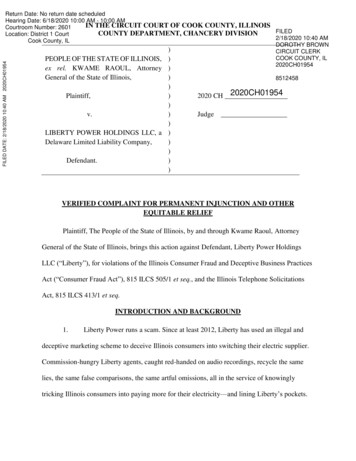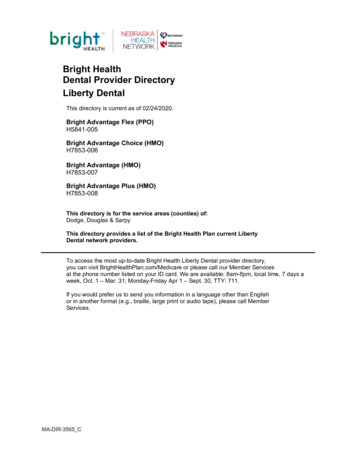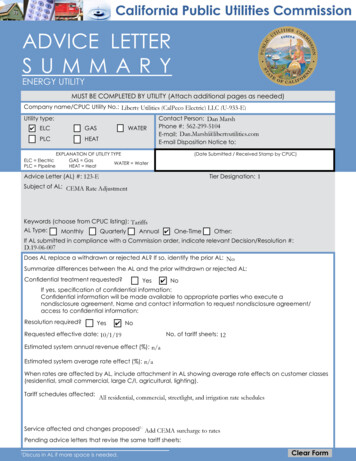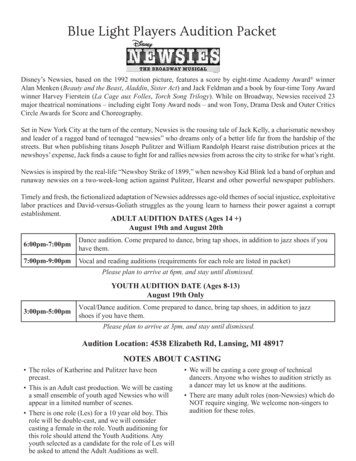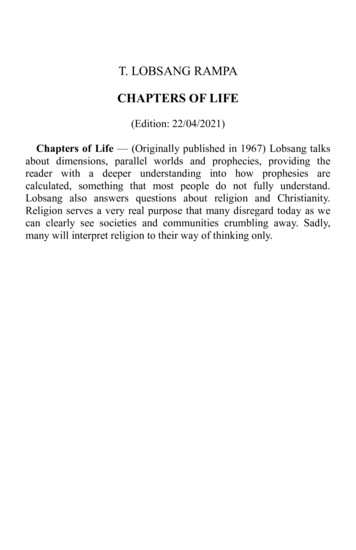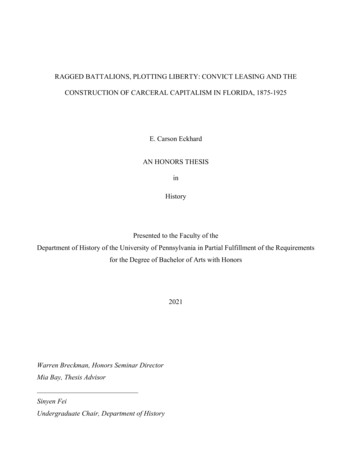
Transcription
RAGGED BATTALIONS, PLOTTING LIBERTY: CONVICT LEASING AND THECONSTRUCTION OF CARCERAL CAPITALISM IN FLORIDA, 1875-1925E. Carson EckhardAN HONORS THESISinHistoryPresented to the Faculty of theDepartment of History of the University of Pennsylvania in Partial Fulfillment of the Requirementsfor the Degree of Bachelor of Arts with Honors2021Warren Breckman, Honors Seminar DirectorMia Bay, Thesis AdvisorSinyen FeiUndergraduate Chair, Department of History
iAcknowledgementsThis project would not have been possible without the many people who supported me along the way.I would like to thank my advisors, Mia Bay and Warren Breckman for their constant support,encouragement and feedback on every draft. I am also grateful to the Andrea Mitchell Center for theStudy of Democracy, whose financial support made my archival research possible. I would also like tothank Jeff Green, Matt Shafer, Gideon Cohn-Postar and Paul Wolff Mitchell for their feedback andsupport throughout this process. Thank you also to Scott Wilds for his genealogical assistance, on thisproject and on others throughout my time at Penn.I would also like to thank Kathleen Brown for inspiring me to pursue historical research and supportingme these past four years, and Gabriel Raeburn, for introducing me to Penn’s History Department.Additionally, Natalia Rommen and Misha McDaniel’s love, listening and support empowered methroughout this project. Lastly, I am endlessly grateful to my family and friends, whose encouragementand patience made this process possible and enjoyable. I am especially thankful for my grandparents,Janie and Harry Cline, who have nurtured my love of history since I was a child. This thesis is dedicatedto them.
iiAbstractThe convict-leasing system, which rose to prominence across the South in the wake of the Civil War,was a system of incarceration in which convicts, who were often Black men and women convictedof petty crimes, were leased to private developers, who used them as a large, unfree labor force. Bythe onset of the 20th century, Florida had one of the largest and most brutal systems of convictleasing in the nation. Unlike other states, who primarily utilized the convict-leasing system as ameans of sustaining the agricultural economy of the slavery-era, Florida employed convict-leasingto economically develop the state through the construction of infrastructure and the rise of theturpentine and lumber industries. Florida’s reliance on the lease system for the construction ofindustry throughout the state sets it apart from the penal systems of other Southern states, andaccounts for the relative magnitude and harshness of Florida’s leasing system; a thorough analysisof convict leasing in the state therefore provides a historical lens through which to consider the rootsof the American private prison and modern industrial penal labor more generally.
iiiTable of ContentsIntroduction1Chapter 1: “Prisoners Profitable”: The Rise of Carceral Capitalism in the Sunshine StateFlorida and Its Neighbors: A Comparative Overview of Southern Penal Policy in the “New”South, 1865-1910Florida’s Early Penal System, 1840-1877The Business of Convict Leasing in Florida:Conclusion13Chapter 234“This Giant School of Vice and and Crime:” Capitalism and Conditions Inside Florida’sConvict CampsE.B Bailey and his Convict Business: A Case StudyA New Plantation: The Layout of the Convict CampThe Trusty SystemContractors and Capital: Disease, Death and Deceit343540454913212732Chapter 3: Corruption, Capital and Counteraction: Convict Leasing and the Florida Boom57Corruption at the State Level58“Manufacturing Convicts:” Local Corruption and the Convict Economy66Making it in Hell: Black Resistance to the “Manufacture of Convicts”73Conclusion79Works CitedPrimary SourcesSecondary Sources858690
1IntroductionIn January of 1922, twenty-two-year-old Martin Tabert died within forty days of arrivingat a county convict camp, brutally whipped to death in the swamplands of northwest Florida.Originally from North Dakota, Tabert had been arrested for riding a train in Tallahassee withouta ticket while on a journey to “see the sights” of the world.1 Unable to pay the 25 fine, the youngman received a hefty sentence: ninety days of labor.2 The state immediately leased Tabert to thePutnam Lumber Company for the duration of his sentence. In an instant, Martin Tabert hadbecome a victim of the convict-leasing system, under which the state of Florida and its countiesleased prisoners to private businesses for profit.Condemned to working long days “waist-deep in swampy water” and “fed and housed ina way that no North Dakota farmer would feed and house his domestic animals,” Tabert quicklybecame sick.3 After he developed a fever and debilitatingly swollen feet, Tabert was sent to thecamp’s “whipping boss,” Walter Higgenbotham in late January.4 Beaten severely with a sevenand-a-half-pound strap, Tabert died shortly after the torture.5Like the deaths of many who died in Florida’s convict camps, Tabert’s fate was initiallyshrouded in secrecy. Even his parents did not learn the details of his tragic passing for six monthsuntil, in July 1922, a former prisoner named Glenn Thompson wrote to Munich, North Dakota,1Carper, N. Gordon. "Martin Tabert, Martyr of an Era." The Florida Historical Quarterly 52, no. 2 (1973): 119.Accessed February 21, 2020. www.jstor.org/stable/30149028. p.1162Carper, N. Gordon. "Martin Tabert, Martyr of an Era." The Florida Historical Quarterly 52, no. 2 (1973): 119.Accessed February 21, 2020. www.jstor.org/stable/30149028. p.1163Johnson, James Weldon, “This Civilized Land,” The New York Age, April 7, 19234Carper, N. Gordon. "Martin Tabert, Martyr of an Era." The Florida Historical Quarterly 52, no. 2 (1973): 119.Accessed February 21, 2020. www.jstor.org/stable/30149028.5Johnson, James Weldon, “This Civilized Land,” The New York Age, April 7, 1923
2asking if Tabert’s next of kin wanted to hear the “particulars'' of his death.6 Appalled to hear aboutthe conditions of their son’s incarceration and torture that he suffered, the Tabert family launcheda widely-publicized investigation into their son’s death, even enlisting the help of the stateattorney of North Dakota in their efforts to demand justice for their son.Largely due to his parents’ considerable wealth, Tabert’s story gained national attention,garnering sympathy, grief, and outrage. Headlines across the country labeled the death a tragedy,and convict leasing an aberration. “Tragedy of North Dakota Farm Boy Who Was Beaten to Deathin Florida Peonage Camp,” declared the St. Louis Post-Dispatch in a full-page spread detailingTabert’s death and the state’s initially apathetic response; the reporter noted with horror that “anyfarm boy could meet the same fate.”7 From Wisconsin and North Dakota to Alabama and Nebraska,the gruesome details of Tabert’s demise became a media sensation, resulting in widespread calls forthe conviction of his killer and reform of the convict leasing system. By July 1923, media coverageof Tabert’s death stretched from Canada to Hawaii, and Florida’s convict leasing system had becomea source of state embarrassment on the international stage.8As his story gained national attention, Tabert’s death quickly became equal parts Floridafolklore and focal point of anti-carceral activism, establishing Tabert as a hero and martyr. A 1923edition of The Miami Herald contains a “ballad song” entitled “Martin Tabert of North Dakota (aballad to be sung in minor key but at the end with shouts”), exemplifying Tabert’s mythologicalstatus.9 The song functions as both a ghost story and a rallying cry against the convict leasing system,the lyrics warning the listener that “the whip is still in the convict camps, for Florida’s stirring now 6Johnson, James Weldon, “This Civilized Land,” The New York Age, April 7, 1923“Tragedy of North Dakota Farm Boy Who Was Beaten to Death in Florida Peonage Camp,” St. Louis Post-Dispatch,08 April 1923.8“Whipping Boss to Serve 20 Years,” Honolulu Star Bulletin, 9 July 1923.9“Martin Tabert of North Dakota,” from “The Galley,” The Miami Herald, April 20, rms Martin%2BTabert7
3Martin Tabert of North Dakota, you can rest from your walking now.”10 Reprinted across thecountry, the “Ballad of Martin Tabert'' quickly became familiar to school children nationwide, whileop-eds demanding changes to Florida’s penal system proliferated. A few days after the balladappeared, the Herald printed that Amos Pinchot, a prominent “frequent Florida visitor” and thebrother of Pennsylvania governor Glifford Pinchot, wrote to several well-known leaders of women’ssocial organizations in the state, entreating them to not consider “Higgenbotham alone” to be at faultfor Tabert’s murder, but instead to blame “Florida’s penal laws and regulations.”11 The advocacy ofestablished Floridians and Northern politicians and businessmen soon proved pivotal in piquingnationwide public interest and leveraging Tabert’s death as an opportunity for systemic reformthroughout the state.The barrage of press coverage continued into 1924, and the story of Tabert’s death at thehands of the brutal Florida penal system appeared on the front page of more than fifty newspapersacross the nation.12 Northern newspapers indicted Florida state legislators for the crime, declaringtheir role in Tabert’s death to be equal to that of the prison camp’s overseer. After Tabert’s familyhired renowned lawyer Gudmunder Grimson to assist the state of Florida in the prosecution ofHiggenbotham, new grisly details of the convict leasing system emerged, illustrating the degree towhich capitalism and corruption underscored the state’s nascent criminal justice system. Grimsonfound that Sheriff J.R Jones, who oversaw Tabert’s arrest, had a tacit agreement with the PutnamLumber Co., and received compensation for every convict, which encouraged him to “endeavor toobtain the arrest and conviction of men for pretended or petty offenses.”13 Moreover, the judge who10Ibid“The Galley,” The Miami Herald, April 20, rms Martin%2BTabert12Holt, Anne Haw. "Men, Women and Children in the Stockade: How the People, the Press, and the Elected Officialsof Florida Built a Prison System." (2005). Page 14213Journal of the House, North Dakota State Legislature, Issue 18. 23 February 1923.11
4sentenced the 22-year-old had also conspired with Jones and the lumber company, revealing theconvict camps of Leon County and the justice system that furnished them to be entirely profitfocused, rather than concerned with the moral reform of its prisoners, as the lessees often publiclyclaimed to be. Tabert’s case, and the testimony of other prisoners who had witnessed or personallyexperienced similar abuses, undermined the public image of the convict camp as a mechanism forreforming deviant citizens, and inspired national debate on the role of the prison in American society.Tabert was far from the first man to die after a brutal beating in a convict leasing camp, andhe would not be the last. However, unlike the majority of men who served time in the Floridaconvict-leasing system, Martin Tabert was white, educated, and from a relatively affluent family.The New York Age noted these distinctions in their reporting on the case:But after all the case of Martin Tabert is unique only because itis the case of a white man taken up and championed by a greatnewspaper. The case of Tabert, as terrible as it is, could bematched and out-matched by the cases of thousands of Negroeswho have suffered and died under the systems of convict leasingand peonage.14The overwhelming majority of people who died as a result of Florida’s convict-leasing policiesremain unknown, and the circumstances of their deaths remain shrouded in ambiguity andanonymity. As The New York Age noted, most of them were Black men, arrested for petty crimes,who hailed from Florida and surrounding Southern states. By some estimates, the percentage ofBlack men entrapped the Florida convict leasing system was as high as 80% of all incarceratedpeople in the state, a figure that generally parallels the racial demographics of individual convictcamps.15 One 1914 report from the Ocala Prison farm, not far from where Tabert died, shows that14Johnson, James Weldon, “This Civilized Land,” The New York Age, April 7, 1923See “Records of Ocala Prison Camp,” S42, Box 27, File 6, p. 7, Florida State Archives, Tallahassee; Florida. Dept.of Agriculture. Biennial report of the Department of Agriculture of the State of Florida . Tallahassee, Fla.: [State ofFlorida]. P 167. https://babel.hathitrust.org/cgi/pt?id uiug.30112112107492&view 1up&seq 16715
5more than eighty percent of prisoners held there were Black.16 Despite the fact that most prisonerswere Black, many Southern newspapers declined to note the overt racism that underscored andenabled the “second slavery” of convict leasing. Instead, the region’s journalists painted Tabert as asingular martyr who represented the brutality of a system that could victimize “any young man,”rather than one that disproportionately exploited and harmed Black Floridians. Tabert’s whitenessand his family's affluence ultimately catapulted his case to one of infamy nationwide, and eventuallyproved to be a primary mobilizing force in the movement to abolish convict leasing.In May 1923, nearly a year and a half after Tabert’s death, Florida formally ended the practiceof corporal punishment and the county convict lease system, and began instead constructing newpenitentiaries for incarcerated people or exploiting their labor for public, not private, projects.17However, the violence of the convict camp remains foundational to the history of crime andpunishment in Florida, and indeed the United States as a whole. In addition to the horrific abusesthey suffered, leased convicts comprised much of the labor force that built modern Florida’sinfrastructure during the late 19th and early 20th centuries, transforming the nation’s 27th state froma marshy wilderness into a budding region of industry and paving the way for later inmate laborpolicies and practices. Although the practice of convict leasing was by no means exclusive to Florida,the state quickly gained notoriety for its large, fully privatized practice of convict leasing, whichfostered a complex system of subleasing that ensured that the business of prisons became amoneymaking venture, both for prominent capitalists and the state itself.18 Moreover, Florida’s16Records of Ocala Prison Camp, S42, Box 27, File 6, page 7, Florida State Archives, TallahasseeFlorida, Acts and Resolutions, 1923, (c.9332), 23 May ; Note that abusewithin Florida prisons and jails continued, both on chain gangs and in carceral facilities throughout the 20th century.See Kimmerle EH, Wells EC, Jackson A. January 18, 2016. Summary of Findings on the Investigation into the Deathsand Burials at the Former Arthur G. Dozier School for Boys in Marianna, Florida. University of South Florida:www.forensics.usf.edu/boothill18With the exception of Virginia, every state in the former Confederacy engaged in some form of convict leasingduring the latter half of the nineteenth century. Mancini, p. 217
6reliance on the lease system as a chief mechanism for the state’s economic and infrastructuraldevelopment sets the state’s carceral landscape decidedly in a category of its own.This thesis explores the ways in which the convict leasing system shaped the economicand social development of Florida. The convict-leasing system, which rose to prominence in thewake of the Civil War, was a system of prison labor in which convicts, who were often Blackmen and women convicted of petty crimes, were leased to private developers, who used them asa large, unfree labor force. Unlike other states, which primarily utilized the convict-leasing systemas a means of sustaining the agricultural economy of the slavery-era, Florida employed convictleasing to economically develop the state through the construction of infrastructure and the riseof the turpentine and phosphate industries. Likewise, Floridian industrialists such as HenryFlagler, E.B Bailey, and J. Buttgenbach relied heavily on convict leasing to furnish labor for theirindustrial projects, which included the establishment of a railroad throughout the state andextensive agricultural enterprises.This project will examine how convict-laborers became a considerable force of urbandevelopment and industry in Florida, and explore the ways in which Florida’s nascent, privatizedpenal system laid the foundation for 20th century mass incarceration. Florida’s convict leasingsystem, like those of neighboring states, rose to prominence after the Civil War, and quicklybecame ingrained in the state’s socio-legal fabric as a primary means of maintaining a whitesupremacist labor system. Importantly, Florida’s reliance on the lease system for the constructionof industry throughout the state sets it apart from the penal systems of other Southern states, andaccounts for the relative magnitude and harshness of Florida’s leasing system; a thorough analysisof convict leasing in the state therefore provides a historical lens through which to consider theroots of the American private prison and modern industrial penal labor more generally.
7Some historians have suggested that convict leasing in the post-bellum South serves as avaluable lens through which to consider the social history of the South in the years afterRedeemers came to power following Reconstruction. Among them is Mathew Mancini, whodescribes leasing as a “method of criminal punishment that reveals much about the economic andpolitical condition of the society that spawned it, and. that nurtured and cultivated it once it hadcome into being.” Other authors, including Alex Lichenstein and Gordon Carper have consideredconvict leasing as a defining aspect of the South’s postwar transition to a developed economy.19Scholars generally agree that the convict leasing system epitomized the “deepest impulses” of thepostwar South, serving as a means of reinforcing white supremacy and reflecting the regions’economic precarity. Mancini, in his regional study on the lease system notes that “all majorthemes of the period in Southern history were clustered together within that institution: fears of alabor shortage, racism, the dearth of capital, hair-trigger violence, the courageous efforts ofhumane reformers, and through it all, the struggle to modernize.”20Florida simultaneously fits this mold and shatters it. As I argue throughout this thesis,Florida’s reliance on convict labor to establish industry in the state further exacerbated thecruelties of convict leasing, while the routine, and often linked, corruption of capitalists andlawmakers ensured that leasing did not “just happen,” but was instead the realization of aconcentrated effort to accelerate Floridian industry. As a result of this deliberate design, I arguethat Florida’s convict lease system constitutes an early realization of what Jackie Wang terms“carceral capitalism,” which comprises the intertwinement of anti-Black racism and the profit19Drobney, Jeffrey A. "Where Palm and Pine Are Blowing: Convict Labor in the North Florida Turpentine Industry,1877-1923." The Florida Historical Quarterly 72, no. 4 (1994): 411-34. Accessed September 14, 2020.http://www.jstor.org/stable/30150422.; Lichtenstein, Alexander C. Twice the Work of Free Labor: The PoliticalEconomy of Convict Labor in the New South. Verso, 1996.20Mancini, 2
8motive of the modern prison in the creation of American mass incarceration. Carceral capitalismthus seeks to locate the “carceral continuum alongside and in conjunction with the dynamics oflate capitalism.”21 Although traditionally examined in relation to the carceral boom of the late20th and early 21st century, the theory of carceral capitalism certainly applies to the convictleasing system of Jim Crow Florida with equal force, as exemplified by the state’s total emphasison both state and private profit, and open condonement of gratuitous violence.According to Jeffrey Drobney, there were three principal reasons for the early success andwidespread public support for convict leasing in Florida. First, convict leasing provided a convenientmeans of relieving the state of "the heavy financial burdens of maintaining a central prison” in thewake of the Civil War.22 Secondly, Florida’s 20,000,000 acres of “virgin wilderness” offeredpotential to industrialists and developers who endeavored to establish industry in the state whilemaking a considerable profit. Lastly, to justify the economic needs of the state and the interests ofthe lessees, a new penal philosophy emerged in Florida and throughout the South afterReconstruction: a form of “penal humanitarianism” that espoused hard labor as a moralizing forcedesigned to allow incarcerated people to “develop habits of industry and a willingness to work.”23This ethos became foundational to the pro-leasing rhetoric employed by both state officials and thosehoping to lease incarcerated Floridians for profit, with many potential lessees boasting of theirpotential for moral instruction through labor in their bids.2421Wang, Jackie, “Introduction”, Carceral Capitalism and “Carceral Capitalism: A Discussion” Building theCommune Chicago, February 19, 2019; -Carceral-CapitalismIWE-PRINT.pdf22Drobney, 41423Drobney, 41624Bids for and Information Pertaining to the Leasing of State Convicts, 1909. S42, Box 07, File 2, The Florida StateArchives
9It is notable that this philosophical “justification” for convict leasing appears to bedecidedly a product of the Reconstruction-era American South; in fact, the South’s penalhumanitarianism diametrically opposed the moral penal philosophy then common in Europe andthe Northern US. As early as 1829, prison reformers in the North proposed a penal systemcentered around solitary meditation within a penitentiary, most notably in New York andPennsylvania. By the end of the Civil War, Auburn State Prison in New York, and Eastern StatePenitentiary in Pennsylvania had become models for “social purification” through solitary orsilent incarceration, with an emphasis on sanitation, and relatively light work to promote “nonidleness.”25 Given the popularity of reformist prisons in the US and Britain, it is particularlynotable that Florida’s model focused so heavily on labor, capitalism and overt exploitation whilenevertheless incorporating the same language of moral reform and purification that permeatedNorthern efforts to create a prison system focused on rehabilitation rather than punishment.Although in conflict with their era’s prevailing idea about carceral reform, the ethos ofSouthern justifications for convict leasing were not entirely new. In framing convict leasing as amoral good, ostensibly predicated on inspiring moral purity and industriousness in prisoners,Southern planters and industrialists repurposed the very language used to debase formerly enslavedpeople after Emancipation, which in turn derived its ideals from the paternal ethos of chattel slavery.Throughout Reconstruction, Floridian newspapers routinely portrayed free Black people as lazy orburdensome to the state. Often accompanied by calls for legislation or police action to “control” theBlack population, such rhetoric ultimately inspired the criminalization of “idle” behavior, includingstatutes criminalizing vagrancy, “strolling and wandering,” and other contrived crimes.26 Just as25Thorsteinson, Katie, “19th Century Prison Reform Collection,” Cornell University Library Digital lections/prison-reform;26Constitution of the State of Florida, 1865. “An Ordinance on Vagrancy.” page id 53
10convict camp captains would argue more than a decade later, Southern Democrats of theReconstruction era postulated that hard labor was beneficial to newly-freed Black Floridians. Oneauthor, writing for the Tallahassee Semi-Weekly Floridian in 1865, suggested that “a little necessaryharshness” could promote industriousness among Black Floridians, arguing that the abuse wasactually “a charity, since it would save them from crime and the suffering and punishment whichmust ensue from a life of idleness and vagrancy.”27 Ultimately, this ethos would evolve into ardentsupport for the convict leasing system, and supply justification for corporal punishment. In the statelegislature, at the desks of Floridian industrialists, and at guard posts in convict camps, the notionthat Black people were “improved” by hard labor and physical abuse protected those who inflictedpunishment and legitimized the tortures of the carceral system to the Floridian public.Lacking a workforce willing to clear land and toil in the turpentine operations, wealthyinvestors relished the opportunity to secure an unpaid, unfree labor force who had no ability toorganize around workers’ rights or abandon their assigned posts in favor of safer or more lucrativework. The leasing system also served as a means of guaranteeing the limitation of BlackFloridians’ social prospects; while Northern penitentiaries emphasized teaching skilled laborwithin the prison workroom, Floridian convicts, like those in other Southern states, weredeliberately kept from learning skilled labor during their incarceration, lest “the penitentiarybecome a school for the promotion of bad men over good.”28 In short, through convict leasing,Florida created a self-perpetuating system that all but ensured prosperity for leading industrialistsand state lawmakers alike while exerting near-total control over the state’s Black labor force. Toprominent Florida democrats, the onset of convict leasing must have seemed like something of a27“Address the Negroes,” The Semi-Weekly Floridian, Tuesday, September 26, 1865, r, “Prison Labor,” 248
11foolproof plan, a guaranteed means of developing the state’s industry and infrastructure whilekeeping the state’s population of free Black citizens firmly under the thumb of white supremacy.In three chapters, this work explores the foundations, practice and legacy of Florida’s Jim Crowjustice system as a disastrous and influential experiment in privatized prison labor and carceralcapitalism.Chapter 1 explores the early history of the carceral state and convict leasing in Florida andprovides a brief comparative analysis of Florida’s nascent leasing system to those of neighboringstates. Throughout, I consider the ways in which convict leasing in Florida functioned as a“second slavery” in the state while also catalyzing industrial growth and enriching wealthyinvestors at the expense of Black convicts. I argue that, between 1868 and 1899, Florida laid thegroundwork for a distinct path to industrialization and development through convict labor, aphenomenon that sets Florida’s penal system apart from those of other Southern states, who didnot rely as substantially on convict labor for statewide growth.Chapter 2 focuses on the relationship between carceral capitalism in Florida and thebrutality of Florida’s convict camps, linking barbarous conditions to an emphasis on capital gains.The chapter focuses largely on the activities of industrialist EB Bailey, whose rise to prominencewithin the Florida carceral business provides an important case study on the practice of convictleasing during the late 19th century. Lastly, Chapter 3 explores the relationship between resistanceand corruption, analyzing how incarcerated people, mainly Black Floridians, resisted theFloridian carceral state from the moment it took shape. In response to this resistance, corruptionwithin the Florida prison business only grew as industrialists sought to retain and subdue theirunfree labor forces and local lawmakers and sheriffs proved determined to continue to exerciseoppressive control over Black communities across the state.
12The implications of Florida’s lease system are long-reaching; nearly a century later,carceral capitalism continues to dominate the state’s justice system. Today, Florida incarceratesnearly 100,000 people in prisons scattered across the state. Privatized prisons have become aubiquitous aspect of the state’s carceral landscape, while prison labor persists in Florida’s prisonsand throughout the country. Throughout this thesis, I argue that the contemporary climate ofincarceration in Florida was indelibly shaped by the state’s violent history of the lease system.Florida’s Jim Crow justice system with its dearth of state oversight, harsh sentencing policies,and focus on private economic development and state industrialization became an early prototypefor the carceral capitalism of the post-Reagan era. The history of convict leasing in Florida thusprovides an important lens through which to consider the failures of present-day incarceration, inFlorida and beyond.
13Chapter 1: “Prisoners Profitable”: The Rise of Carceral Capitalism in the Sunshine StateFlorida and Its Neighbors: A Comparative Overview of Southern Penal Policy in the “New”South, 1865-1910In 1903, Carrie Kinsey of Bainbridge, Georgia penned a letter to Theodore Roosevelt,imploring the President to intervene in Georgia’s peonage system and save her brother, a boynamed James Robinson who was “about fourteen.”29 Kinsey detailed how her brother had beenpromised a job, only to be sold to Edward McCree, who operated a plantation called Kinderlou,where he and his brothers forced hundreds of young Black men to work the land throughpeonage.30 Carrie’s brother labored at Kinderlou, alongside state convicts, leased to the McCreebrothers
7 “Tragedy of North Dakota Farm Boy Who Was Beaten to Death in Florida Peonage Camp,” St. Louis Post-Dispatch, 08 April 1923. 8 “Whipping Boss to Serve 20 Years,” Honolulu Star Bulletin, 9 July 1923. 9“Martin Tabert of North

